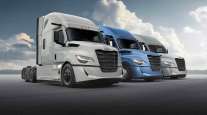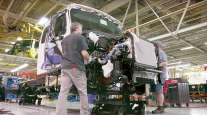Senior Reporter
DTNA Sees Surging Truck Market in 2018

When Daimler Trucks North America looks at 2018, it anticipates a surging truck market, constrained supply lines, customers’ need for faster uptime aided by predictive technology and the steady advance of electric powertrains, the company’s top executive said.
All this is happening as DTNA enters the year tracking ahead of its record 2017 market share in NAFTA sales of Classes 6-8 trucks. The manufacturer ended January with a 42.3% share of Classes 6-8 trucks compared with the company’s 2017 overall share of 39.8%.
The 2017 share was “the highest ever achieved by DTNA, and, honestly, by any other OEM in this market,” Roger Nielsen, the truck maker’s CEO, said. He spoke with reporters during an online roundtable Feb. 27.

Nielsen
“The driver in our growth in market share was definitely the U.S. Class 8 market,” Nielsen said, as buyers responded to the latest iteration of DTNA’s Cascadia model, ordering over 46,000 of them last year. It took nearly four years to get 25,000 orders for the first version of the Cascadia, which was less fuel efficient, he said.
Nielsen added that Western Star, the company’s niche brand, set its own a record for orders, but he did not quantify those results.
DTNA’s truck orders in February may not reach record territory, but they’ll get close, he added.
Looking ahead, the coming year is expected to bring a significant increase in sales of medium- and heavy-duty trucks and approach what was experienced in 2015, when Classes 6-8 NAFTA sales reached 420,000 units.
“It could be higher, especially if the current market dynamic continues,” he said.
North American Class 8 orders in January were 48,700, according to ACT Research Co., the second-highest total ever.
To meet the demand, DTNA is increasing its production capacity “everywhere” as its backlog already extends into the third quarter, Nielsen said.
But the hot market has constrained DTNA’s supply chain, he said.
“Definitely, the market has an upper limit. We have capacity, but every supplier also has to follow pace. If I look at the constraints our suppliers are facing, it’s not necessarily raw materials, it’s labor — with unemployment rates low, it’s finding people to work the second and third shifts,” he said.

DTNA's Cascadia at a truck show last year. (Philip Scott Andrews)
Turning to parts and service, 80% of DTNA’s dealer network is within 350 miles of a parts distribution center, of which it has nine, allowing for rapid delivery of parts.
Also, it will be expanding Alliance Truck Parts division to retail store operations throughout the country to sell steel wheels, slack adjusters, brake air compressors and more.
Alliance parts currently are sold at more than 800 locations, including DTNA dealerships in the United States and Canada plus TravelCenters of America and Petro truck stop locations nationwide.
Based on data gathered from a sample of DTNA’s fleet customers, while 55% of all truck repairs are done within 24 hours, fleets need faster service, Nielsen said.
“What we have learned, is that’s not good enough. Customers would like to get the repair completed in 10 hours, matching the break period of the drivers,” he said.
The next step is predictive analytics, he added. “This is going to change how trucks are serviced. Customers want to avoid costly downtime, costly repairs and, particularly, unscheduled repairs. So the more we can predict when a truck [part] is going to fail, the better off it will be to get it into a shop and repaired.”
To go along with that, DTNA will cover the warranty costs for a part replaced based on predictive diagnostics, and is changing its “attitude” to fix-as-predicted-to-fail, he said, compared with the widespread fix-as-fail approach, he said.
Looking ahead toward electrification, DTNA is in conversations with various entrepreneurial companies offering different powertrain-related technologies such as battery management software, hydraulic hybrids and robotic driving — even as it leverages the resources of its parent company, Daimler AG.
“We work with those guys, launch those guys, [sometimes] invest in them when we want a particular element of what they are providing to give us a cost advantage or a time-to-market advantage. We are very curious people,” Nielsen said.
DTNA’s parent company, Daimler AG, in its latest earnings report emphasized that its future lay in the combination of connectivity, autonomous, sharing and electric mobility technologies.
For DTNA, that future does not include hydrogen fuel cells as more than a supportive technology, Nielsen said. “At the moment we do not, on the trucking side, see us pursuing a hydrogen fuel-powered vehicle,” he said.
However, the company has discussed them as possibly serving as range extenders for battery-electric vehicles. “No announcement to make, but it is always on the list of solutions,” he said.
Lastly, electrification will play out much like the decades-long effort to improve the fuel efficiency of diesel engines, he said.
“It’s all about range, using less electricity and getting more miles. So that continues on,” Nielsen said.




